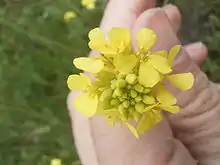| Rapistrum | |
|---|---|
 | |
| Rapistrum rugosum | |
| Scientific classification | |
| Kingdom: | Plantae |
| Clade: | Tracheophytes |
| Clade: | Angiosperms |
| Clade: | Eudicots |
| Clade: | Rosids |
| Order: | Brassicales |
| Family: | Brassicaceae |
| Genus: | Rapistrum Crantz |
| Species | |
|
Rapistrum rugosum (L.) All | |
Rapistrum, the bastardcabbages,[1] is a genus of the family Brassicaceae with a distinctive cross like arrangement of its petals. Species of Rapistrum are annual to perennials (Lifespan from 1 to 2 or more years). The yellow petals are accompanied by sepals that stand vertically at near right angles (erecto-patent). Leaf shape and arrangement varies from rough toothed (dentate) to a configuration of opposingly lobed pairs along the plant stalk, pinnately lobed.
Fruit
The genus Rapistrum has a characteristic fruit comprising two segments:
a) The distal (upper division) The part of the fruit farthest away from the point of attachment. The distal is endowed with a ribbed spheroid base (globose) that tapers to form a narrowed projection. It holds a single seed.
b) The proximal (lower division) The part of the fruit nearest to the point of attachment. Possesses a more uniform narrower shape compared to the distal above, giving the fruit a waist. It holds a maximum of three seeds, more commonly none or one.
The fruit varies from species to species. The distal of R. rugosum is strongly ribbed and narrows to form a beak whereas R. perenne is comparatively less wrinkled and ends with a style that stubbornly resists detachment, 'a persistent style'.
When ripe the distal breaks away in an across-wise fashion, breaking transversely.
References
- ↑ USDA, NRCS (n.d.). "Rapistrum". The PLANTS Database (plants.usda.gov). Greensboro, North Carolina: National Plant Data Team. Retrieved 18 October 2015.